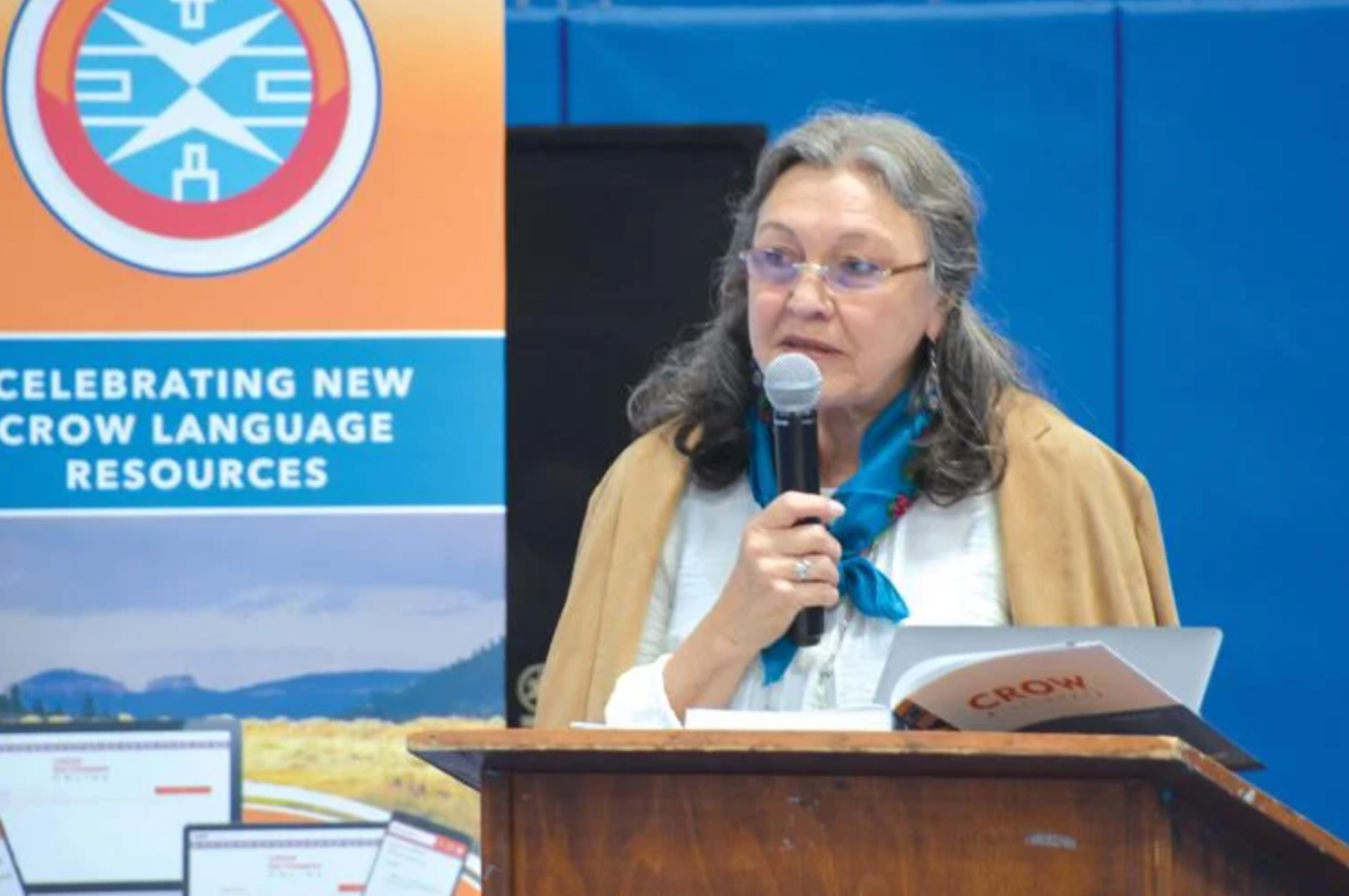Crow celebrate Apsáalooke dictionary print edition
Carrie Haderlie | The Sheridan Press | June 11, 2022

Janine Pease speaks during a celebration of the publication of the Crow Language Print Dictionary June 3, 2022.
CROW AGENCY, Mont. — Jacob Brien’s great-grandma was born in the 1930s, a time when many Native Americans were not only discouraged but punished for speaking their own languages.
Last weekend, Brien gave his great-grandmother a dictionary: A print edition of the Apsáalooke, or Crow, dictionary, featuring over 11,000 words and phrases, chronicling untold cultural significance.
It was a project he worked on firsthand.
In 2014, members of the Apsáalooke tribe formed a nonprofit called the Crow Language Consortium, and have since undertaken a number of initiatives for language revitalization, including documentation and a comprehensive dictionary, development of materials for children and online resources. Partnered with the Language Conservancy in Indiana, Brien completed an internship working on the dictionary after graduating high school. He now plans to go into linguistics.
“My great-grandma was born in 1934. She went to boarding school in South Dakota, and she told me she got so homesick because of how they were treated. She and a couple other girls tried to jump on a train to go home. One group of girls did make it on a train,” Brien said.
The girls in his grandma’s group got scared, and eventually were taken back to the school by a teacher.
“But that first group of girls, they rode on that train, and they froze to death,” Brien said.
According to the National Museum of the American Indian at the Smithsonian, families were often forced to send their children to government- or church-operated boarding schools, where they were forbidden to speak their Native languages. According to a June 2021 Reuters report, at least one academic researcher contends that as many as 40,000 children may have died in or because of their poor care at U.S.-run schools.
“Even until the 1990s, Crow speakers would go to school and the teachers would still say, ‘Hey, don’t speak Crow’,” Brien said.
Today, the dictionary he worked on at age 18 will be used in language immersion coursework on the Crow Agency.
“I’m so glad they are teaching Crow language in schools,” Brien said. “I gave my grandma that dictionary, and she was so happy. She thought it was the greatest thing of all time.”
On June 3, the Crow Language Consortium at Little Big Horn College celebrated the release of the Crow Language Print Dictionary, honoring Crow elders, speakers and knowledge keepers who contributed to the creation of the text. Bob Rugh, publications director at The Language Conservancy, said the print dictionary complements other curriculum materials like an online dictionary and an eLearning Platform called Ammiláau, “our language,” that will cover conversational and grammatical Crow language in an interactive manner, through lessons and exercises, over multiple levels of learning and complexity.
“We are not an English-only speaking country, and we never have been,” Rugh said. “A language has an entire culture behind it, and language and culture can’t be separated. With that comes respect. When we feel that respect, we also hopefully respect the people behind the language and culture.”
Dr. Janine Pease, D. Ed., adjunct faculty member in humanities and social science at Little Big Horn College, said the only other Crow language dictionary was published in the 1970s and had around 2,000 entries. A healthy language has around 30,000 words, and a four-year-old usually has a vocabulary of about 4,000 words, she said.
There are over 11,000 words in the new dictionary, according to Rugh.
“This dictionary has the work of a community of about 80 people, fluent speakers,” Pease said. “We had members who were born in the early 1930s, raised by their grandparents … you have to think, where that language came from. It goes back many generations. They brought us amazing knowledge.”
Today, public and private schools on the Crow Agency offer language immersion classes in both primary and secondary schools. At least half a day’s material is taught in the Crow language in what is called a dual language approach, and teachers switch which half of the day is taught in Crow from day-to-day.
“You might have mathematics or social studies in the Crow language,” Pease said. “If a child starts in pre-K and goes through third grade, they are close to fluency. They have had literally thousands of words put into conversations in all the subjects you have in school.
“Children are learning the language,” she said, adding that from 1880 to about 1950, the language was very restricted, even more so in schools.
“But our families are really strong,” she said. “We are not just surviving. We are a thriving language community. In spite of all of the assimilation efforts, our children retained their language.”

